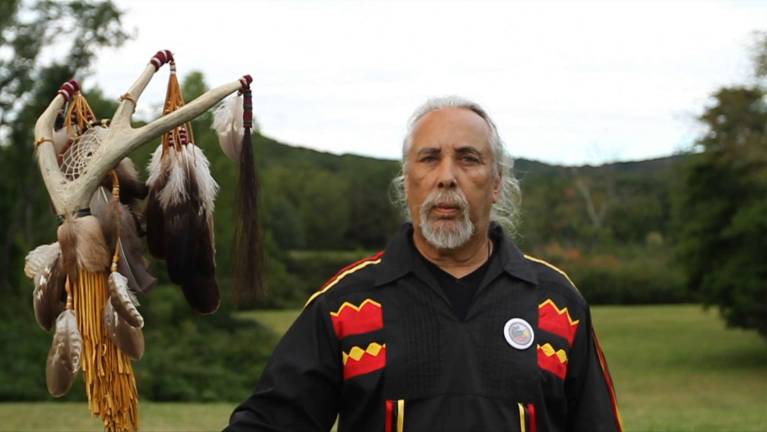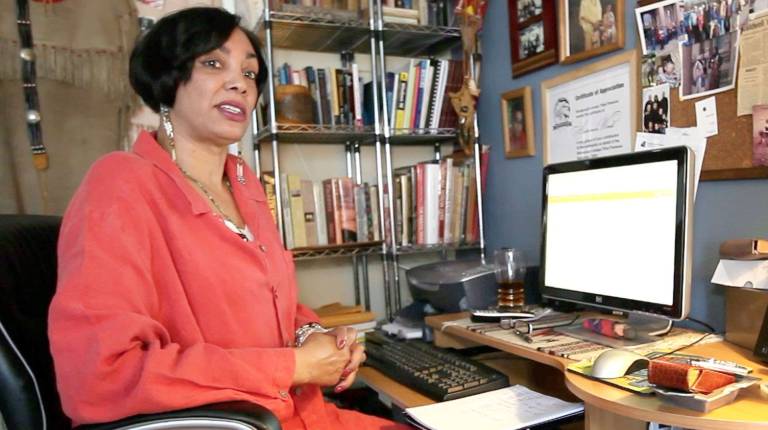Film documents tribe’s struggle for recognition


When Autumn Wind Scott, chairwoman of the New Jersey Commission on American Indian Affairs, received a phone call from two young filmmakers interested in shooting a documentary about the Ramapough Lenape Nation, she was wary.
“They weren’t the first to come and show interest,” said Scott, a member of the Ramapough and a self-described “gatekeeper” for the tribe, which has about 3,800 registered members and around another 3,000 who are eligible. Many reside just 30 miles outside of Manhattan, in Mahwah and Ringwood, N.J. and neighboring Hillburn, N.Y.
“There have been many to come before them to use the tribe to further their own careers or to gain some type of credential in academia. They took but they left nothing for the tribe and in the majority of cases it was to the detriment of the tribe,” she said.
Director Steven Oritt, 40, one of the filmmakers who reached out to Scott, recalled the vetting process, which included a two-hour meeting with the tribe’s leader, Chief Dwaine Perry, who Oritt described as “all bark and no bite.”
“The first thing he said to me was, ‘Why are you here?’” Oritt remembers. After revealing extensive research and some of the experts in Native American affairs he and producer Corey Bobker lined up for the film, Perry softened.
“In doing my research and getting to know him and the rest of the tribe it made a lot of sense, because they’ve been so burned by so many outside media and individuals who have come in and said they want to tell their story,” said Oritt.
The film “American Native,” which screens on Sept. 12 as part of the Harlem International Film Festival and on Sept. 15 at Regal Cinemas in Union Square, chronicles the Ramapough’s ongoing quest for federal recognition. That status, established by an office within the Department of the Interior and currently held by more than 560 tribes, provides certain benefits, including health care and educational services, economic development programs and the right to self-govern.
The 89-minute film reveals the various hurdles of the federal recognition process, in which cultural identity and heritage must be proven on paper. Perry, who appears throughout the film, sometimes riding his motorcycle, fears that without federal recognition and its protections, their land, in an ever-developing section of the state, will remain in jeopardy.
Conflicts bubble up throughout the film. Kerry Holton, president of the federally recognized Delaware Nation in Anadarko, Okla., opposes the Ramapough’s bid for recognition. Ramapough also bump up against members of a private residential community in Mahwah, where the Ramapough have 13 acres of land. Meanwhile, lawmakers fear that, if granted federally recognized status, the Ramapough will open a casino.
“(Gaming is) the very least of what federal recognition is about,” said Scott. “For the people, it’s really about recognition of who they actually are ... and a lot of people don’t get the psychological effects of being denied your race, your ancestry and your history.”
Oritt remembers filming a scene at a planning board meeting in Poughkeepsie, N.Y., where Perry hoped to discuss the repatriation of the recently discovered remains of a Native American person. A federally recognized tribe in Wisconsin participated via conference call, even though Ramapough members attended the meeting in person.
“What they were going through was real,” Oritt said. “While I had read a lot about the marginalization, I hadn’t experienced it first hand.”
The filmmakers came to the story after hearing local lore about the people who lived in the mountains of New Jersey. Bobker, a New Jersey native, introduced Oritt to a college friend from the area, who asked if he ever heard about an isolated community in the mountains, not far from the island of Manhattan.
A Google search led Oritt to depictions of a group of people that sounded like the “bogeyman,” he said.
“Me not growing up in that area, I didn’t take it seriously,” said Oritt, who grew up in Washington, D.C. “These stories are very pervasive.”
WeirdNJ.com recounts the local lore of a “motley group of social outcasts.” A 2010 New Yorker story “Strangers on the Mountain,” which Oritt remembers as mostly interested in the “salacious” elements as opposed to the very real, immediate issues of land use and federal recognition, showed him just how much of the tribe’s story remained untold.
“Dominant society likes to paint the Native American experience with a very broad stroke brush,” said Oritt. “I was interested in the nuance in Native American culture and Native American rights that aren’t in the forefront.”
Scott, a former fashion model with a deep, raspy voice, lives in Toms River, N.J., about an hour and a half south of Mahwah, where much of the film unfolds. A mother and a grandmother who raises her five-year-old granddaughter, Scott strives to provide her family with a sense of their history. She made genealogy books with names dating back to the late 1500s for each of her three children.
“I wanted them to know how deeply rooted we are,” she said. Now retired from modeling, she sells handmade textiles, jewelry, dolls and other crafts. “That they’re here on the backs of people who have had it rough and still do, and it’s a privilege.”